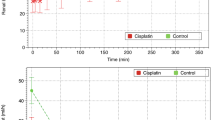Summary
Although transplanting rat kidneys is an established microsurgical technique, inulin clearance is abnormally low, due to rejection and/or warm ischemia-induced damage. In the present studies, rejection was avoided by using inbred Brown Norway rats as donors and recipients. Donor kidneys were flushed with ice-cold solutions of various composition (saline, saline + 200 or 400 mM mannitol) and pHs (5.7, 6.4, and 7.4), and the kidneys were kept cold during transplantation into unilaterally nephrectomized recipients. Renal function was assessed by clearance techniques 1 week later. In control rats, with both native kidneys intact, the ratio of inulin clearance, left kidney to right kidney, was 0.99±0.02. In rats with a native right kidney and a transplanted left kidney that had been flushed with saline, the ratio was considerably lower (0.46±0.09). Adding 200 mM mannitol to the saline flush solution increased the ratio (0.89±0.09). In comparison, adding 200 mM mannitol and 5 mM phosphate buffer at pH 7.4 resulted in a somewhat lower ratio (0.80±0.09), whereas adding 200 mM mannitol and 5 mM phosphate buffer at pH 5.7 resulted in a higher ratio, one that was indistinguishable from control (0.97±0.09). Thus, in this latter group, the inulin clearances of the transplanted kidneys were identical to those of the contralateral native kidneys.
Similar content being viewed by others
References
Andrews PM, Bates SB (1985) Improving Euro-Collins flushing solution's ability to protect kidneys from normothermic ischemia. Mineral Electrolyte Metab 11:309
Andrews PM, Coffey AK (1982) Factors that improve the preservation of nephron morphology during cold storage. Lab invest 46:100
Andrews PM, Coffey AK (1983) Protection of kidneys from acute renal failure resulting from normothermic ischemia. Lab Invest 49:87
Bianchi G, Fox U, DiFrancesco GF, Giovanetti AM, Pagetti D (1974) Blood pressure changes produced by kidney cross-transplantation between spontaneously hypertensive rats and normotensive rats. Clin Sci Mol Med 47:435
Churchill PC, Churchill MC, McDonald FD (1978) Renin secretion and distal tubule Na+ in rats. Am J Physiol 235:F611
Coffman TM, Yarger WE, Klotman PE (1985) Functional role of thromboxane production by acutely rejecting renal allografts in rats. J Clin Invest 75:1242
Coffman TM, Sanfilippo FP, Brazy PC, Yarger WE, Klotman PE (1986) Bilateral native nephrectomy improves renal isograft function in rats. Kidney Int 30:20
Dahl LK, Heine M (1975) Primary role of renal homografts in setting chronic blood pressure levels in rats. Circulation Res 36:692
Donohoe JF, Venkatachalam MA, Bernard DB, Levinski NG (1978) Tubular leakage and obstruction after renal ischemia: structural functional correlations. Kidney Int 13:208
Duncan JI, Heys SD, Thomson AW, Simpson JG, Whiting PH (1988) Influence of the hepatic drug-metabolizing enzyme-inducer phenobarbitone on cyclosporine nephrotoxicity and hepatotoxicity in renal-allografted rats. Transplantation 45:693
Gottschalk CW (1979) Renal nerves and sodium excretion. Ann Rev Physiol 41:229
Jacobsen IA, Pegg DE (1981) Kidney. In: Karow AM Jr, Pegg DE (ed) Organ preservation for transplantation. Dekker, New York, p 553
Kawabe K, Watanabe TX, Shiono K, Sokabe H (1979) Influence on blood pressure of renal isografts between spontaneously hypertensive and normotensive rats, utilizing the F1 hybrids. Jap Heart J 20:886
Klein TW, Gittes RF (1973) The three-kidney rat: renal isografts and renal counterbalance. J Urol 109:19
Maki T, Sakai A, Kountz SL (1975) The rat kidney as a model for the study of preservation methods. Transplantation 20:170
Muller-Suur R, Norlen B-J, Persson AEG (1980) Resetting of tubuloglomerular feedback in rat kidneys after unilateral nephrectomy. Kidney Int 18:48
Norlen BJ, Engberg A, Kallskog O, Wolgast M (1978) Nephron function of the transplanted rat kidney. Kidney Int 14:10
Norlen BJ, Muller-Suur R, Persson AEG (1978) Tubulo-glomerular feedback response and excretory characteristics of the transplanted rat kidney. Scand J Urol Nephrol 12:27
Oesterwitz H, Kaden J, Schneider W, Fritsch W (1988) Failure to prolong rat renal allograft survival time by photochemical donor kidney pretreatment during hypothermic pulsatile kidney preservation. Urol Res 16:53
Pegg DE (1981) Perfusion technology. In: Karow AM Jr, Pegg DE (eds) Organ preservation for transplantation. Dekker, New York, p 477
Provoost AP, DeKeijzer MH, Kort WJ, Wolff ED, Molenaar JC (1982) The glomerular filtration rate of isogeneically transplanted rat kidneys. Kidney Int 21:459
Schreiner GF, Flye W, Brunt E, Korber K, Lefkowith JB (1988) Essential fatty acid depletion of renal allografts and prevention of rejection. Science 240:1032
Silber SJ (1974) Chronic salt-loading of donor and recipient in renal transplantation. Surgery 75:573
Silber SJ, Crudup J (1974) The three-kidney rat model. Invest Urol 11:466
Silber S, Malvin RL (1974) Compensatory and obligatory renal growth in rats. Am J Physiol 226:114
Wallenstein S, Zucker CL, Fleiss JL (1980) Some statistical methods useful in Circulation Research. Circulation Res 47:1
Waynforth HB (1980) Experimental and surgical technique in the rat. Academic, New York, p 178
Author information
Authors and Affiliations
Rights and permissions
About this article
Cite this article
Kline, R., Churchill, M., Churchill, P. et al. High osmolality-low pH flush solutions improve renal transplant function in rats. Urol Res 19, 81–86 (1991). https://doi.org/10.1007/BF00368181
Accepted:
Issue Date:
DOI: https://doi.org/10.1007/BF00368181




